Related Research Articles

Massage is the manipulation of the body's soft tissues. Massage techniques are commonly applied with hands, fingers, elbows, knees, forearms, feet, or a device. The purpose of massage is generally for the treatment of body stress or pain. In European countries, a person professionally trained to give massages is traditionally known as a masseur (male) or masseuse (female). In the United States, these individuals are often referred to as massage therapists, because they must be certified and licensed as "licensed massage therapists".

Shiatsu is a form of Japanese bodywork based on pseudoscientific concepts in traditional Chinese medicine such as qi meridians. Having been popularized in the twentieth century by Tokujiro Namikoshi (1905–2000), shiatsu derives from the older Japanese massage modality called anma.
Rolfing is a form of alternative medicine originally developed by Ida Rolf (1896–1979) as Structural Integration. Rolfing is marketed with unproven claims of various health benefits. It is based on Rolf's ideas about how the human body's "energy field" can benefit when aligned with the Earth's gravitational field.
In alternative medicine, bodywork is any therapeutic or personal development technique that involves working with the human body in a form involving manipulative therapy, breath work, or energy medicine. Bodywork techniques also aim to assess or improve posture, promote awareness of the "bodymind connection" which is an approach that sees the human body and mind as a single integrated unit, or to manipulate the electromagnetic field alleged to surround the human body and affect health.
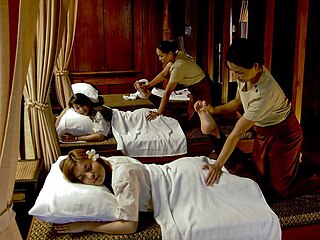
Thai massage or Thai yoga massage is a traditional therapy combining acupressure, Indian Ayurvedic principles, and assisted yoga postures. The idea of Sen-lines alias energy-lines was first used as "Thai yoga massage". These are similar to nadis as per the philosophy of yoga by Gorakhnath.
Manual therapy, or manipulative therapy, is a physical treatment primarily used by physical therapists, physiotherapists, occupational therapists to treat musculoskeletal pain and disability; it mostly includes kneading and manipulation of muscles, joint mobilization and joint manipulation. It is also used by Rolfers, massage therapists, athletic trainers, osteopaths, and physicians.
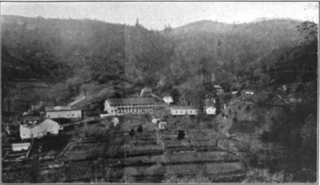
Harbin Hot Springs is a non-profit hot spring retreat and workshop center at Harbin Springs in Lake County, Northern California. Named after Matthew Harbin, a pioneer who settled in the Lake County area. It is located about two hours northeast of the San Francisco Bay Area, in the United States. The facility was partially destroyed in the Valley Fire in September 2015, and was temporarily closed. In January 2019 it partially reopened, including the main pools and sauna, and a limited cafeteria service.

Balneotherapy is a method of treating diseases by bathing, a traditional medicine technique usually practiced at spas. Since ancient times, humans have used hot springs, public baths and thermal medicine for therapeutic effects. While it is considered distinct from hydrotherapy, there are some overlaps in practice and in underlying principles. Balneotherapy may involve hot or cold water, massage through moving water, relaxation, or stimulation. Many mineral waters at spas are rich in particular minerals such as silica, sulfur, selenium, and radium. Medicinal clays are also widely used, a practice known as 'fangotherapy'.
WaterDance or Wata is a type of aquatic therapy which was developed in Switzerland independently of Watsu. While wearing nose clips, a person is gently guided underwater, pulled, swayed, and "flown" while being regularly brought to the surface for breath.

The stone massage is a form of alternative medicine massage therapy and bodywork involving the placement of a number of either heated or cooled stones to the body for the purpose of pain relief, relaxation and therapy. There are a manifold of variations and techniques used in the application of stone massage therapy, deriving from a variety of traditional practices. Stone massages are primarily used to alleviate physical pain issues, however, are also used to promote emotional and spiritual wellbeing in practice.
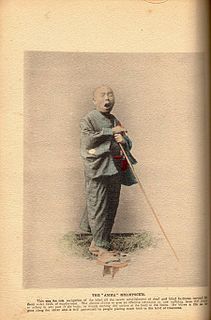
Anma is a practice of traditional Japanese massage; the word also refers to practitioners of that art. Modern shiatsu is largely derived from anma.
Jin Shin Do is a therapeutic acupressure technique developed by psychotherapist Iona Marsaa Teeguarden, beginning in the 1970s.
Anodea Judith is an American author, therapist, and public speaker on the chakra system, bodymind, somatic therapy, and yoga. Judith is the author of Wheels of Life: A User's Guide to the Chakra System. She has maintained a private practice for over twenty years and presents workshops nationally and internationally at holistic retreat centers, yoga studios, Neo-Pagan and New Age events and training institutes. She is a past president of the Church of All Worlds (1986–1993), a founder of Lifeways, a school for the study of the healing and magical arts (1983), and a founding member of Forever Forests. She is on the faculty of Kripalu Center for Yoga and Health, and she is the founder and director of Sacred Centers, a teaching organization focusing on Chakra studies. She has a son named Alex, and one of her brothers is actor and singer-songwriter Martin Mull.
Aquatic therapy refers to treatments and exercises performed in water for relaxation, fitness, physical rehabilitation, and other therapeutic benefit. Typically a qualified aquatic therapist gives constant attendance to a person receiving treatment in a heated therapy pool. Aquatic therapy techniques include Ai Chi, Aqua Running, Bad Ragaz Ring Method, Burdenko Method, Halliwick, Watsu, and other aquatic bodywork forms. Therapeutic applications include neurological disorders, spine pain, musculoskeletal pain, postoperative orthopedic rehabilitation, pediatric disabilities, and pressure ulcers.
Canine massage is a branch of massage therapy that promotes health in dogs. Specifically, canine massage therapy is a form of alternative therapy the benefits of which may include relaxation, increased oxygenation, relief from pain, improved joint flexibility, as well as miscellaneous benefits to the immune system. It uses touch to maintain or improve both physical and emotional well-being. However, be careful and make sure to consult with your vet before attempting to massage your dog yourself.
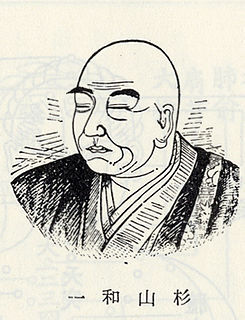
Sugiyama Waichi (1614–1694) was a Japanese acupuncturist, widely regarded as the "Father of Japanese Acupuncture".
Watsu is a form of aquatic bodywork used for deep relaxation and passive aquatic therapy. Watsu is characterized by one-on-one sessions in which a practitioner or therapist gently cradles, moves, stretches, and massages a receiver in chest-deep warm water.
Ai Chi is a form of aquatic exercise used for recreation, relaxation, fitness, and physical rehabilitation. Clinical Ai Chi is distinguished as a specialized, active form of aquatic therapy. In essence, Ai Chi uses breathing techniques and progressive resistance training in water to relax and strengthen the body, based on elements of qigong and Tai chi chuan.
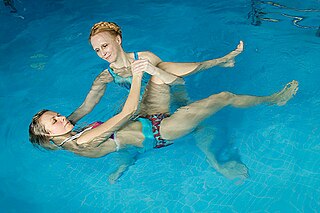
Hydrogymnastics is a water-based therapeutic exercise. As its name suggests, this form of aquatic therapy or aquatic rehabilitation is performed in water, and it can take place in swimming pools at aquatic leisure centres and/or in home pools. Being a form of aquatic therapy, hydrogymnastics aims to improve the physical and psychological health and well-being of an individual. Hydrogymnastics can be performed by anyone, including youths, middle-aged people, the elderly, athletes and those with disabilities. Hydrogymnastics is often assisted by a qualified aquatic therapist and/or exercise physiologist. Although the effects of hydrogymnastics may vary between individuals belonging to different age groups and genders, hydrogymnastics mainly improves one's cardiovascular fitness, strength, balance and mobility.

Joseph Kramer or Joe Kramer is an American sexologist, filmmaker and somatic sex educator. He is the founder of the Body Electric School and of the profession of Sexological Bodywork.
References
- ↑ Associated Bodywork & Massage Professionals, Goodbye Harold, https://www.abmp.com/updates/blog-posts/goodbye-harold. Accessed 27-October-2019
- ↑ Dull H. 2010. Watsu: basic and explorer paths. Watsu Publishing. IBN 978-0984451500.
- 1 2 3 4 Schoedinger, P. 2011. Watsu in aquatic rehabilitation. pp 137-153, Chapter 5 In: Becker, BE and Cole, AJ (eds). Comprehensive aquatic therapy, 3rd edition. Washington State University Press. ISBN 978-0615365671.
- 1 2 3 Jamison, L. 2009. Watsu. pp 117-128, Chapter 8 In: Brody, LT and Geigle, PR (eds). Aquatic exercise for rehabilitation and training. Human Kinetics. ISBN 978-0736071307.
- ↑ Dull, H. 2008. Watsu: freeing the body in water, 4th edition. Watsu Publishing. ISBN 978-1605853710.
- ↑ HSHA. 2014. About us. Harbin School of Healing Arts website. http://www.harbinschoolofhealingarts.org/0110_About_Us.html, Accessed 3-April-2014.
- 1 2 Watsu Europe. 2014. Harold Dull biography. WatsuEurope Website, http://www.watsueurope.com/harolddull/harold-en.htm. Accessed 1-April-2014
- ↑ Dull H. 2007. Finding Ways to Water: Collected Poems 1955-2007. Watsu Publishing. ISBN 978-1604616576.
- ↑ Dull H. 2008. Tantsu: Yoga of the Heart. Watsu Publishing. ISBN 978-1607250111.